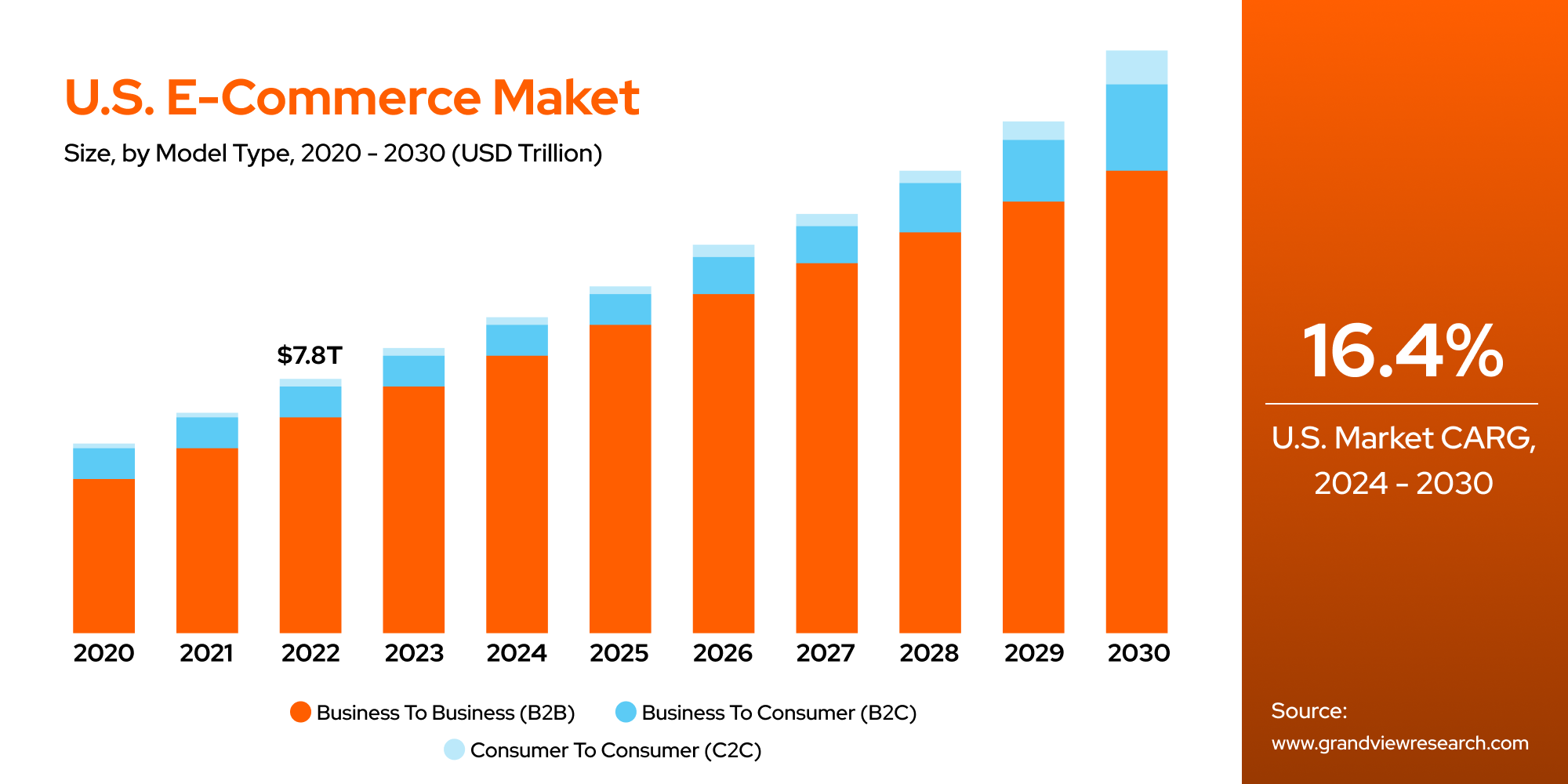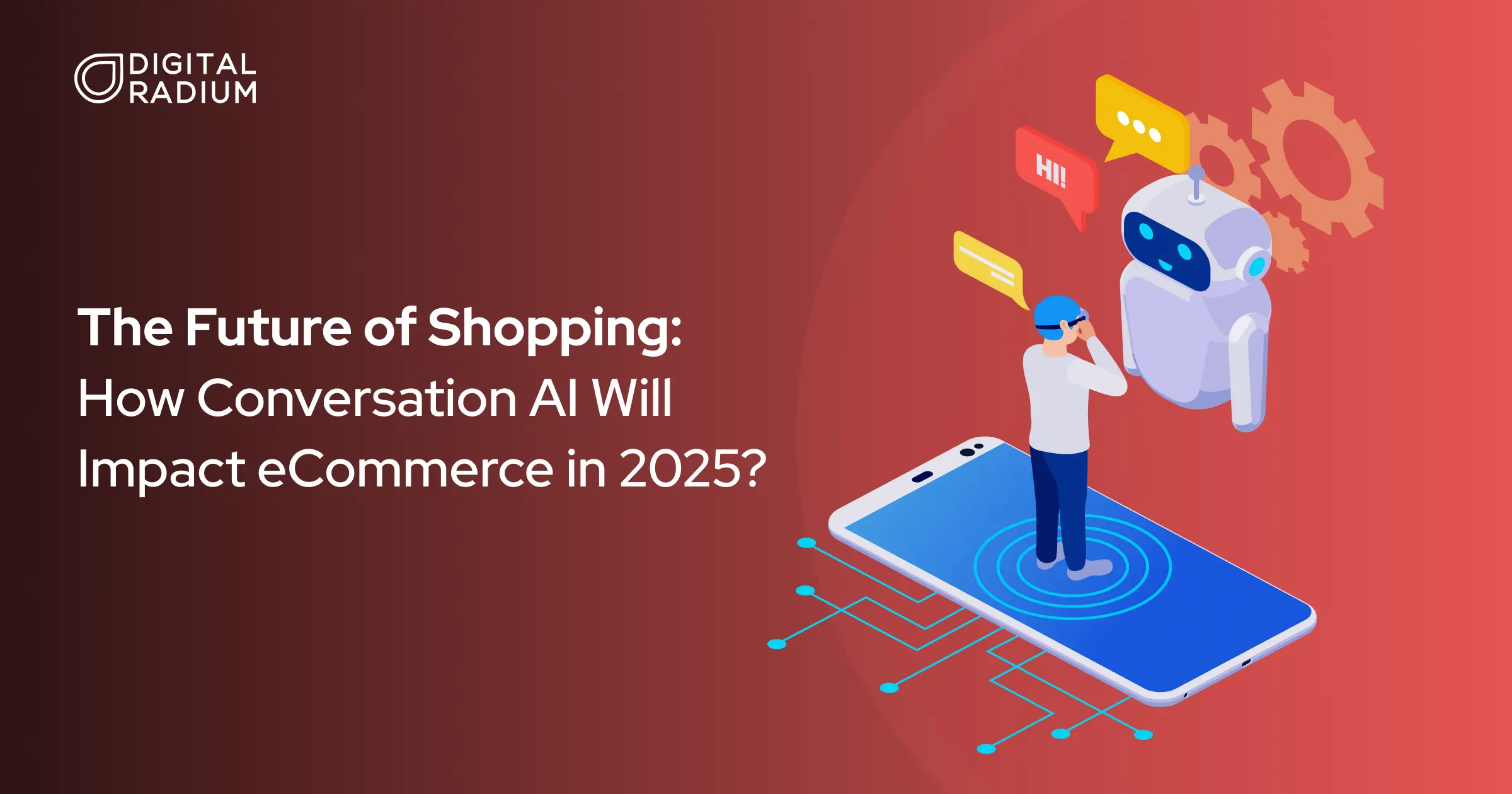In 2024, we are witnessing the intensity of the AI. Integrating AI in work has become more than a trend, its capacity enhances an individual’s work and the growth of an organization. Integration of AI in eCommerce has become more crucial as the market has more competition. According to the research, the US e-commerce market size was estimated at USD 25.93 trillion in 2023 and is projected to grow at a CAGR of 18.9% from 2024 to 2030. Many market experts state that as purchasing habits have increased, AI-powered chatbots, predictive analytics, and digital assistants have also become essential for eCommerce to set up personalized shopping experiences for the user.

One of the trending AI-based integrations implemented in eCommerce is merging online shopping with conversational interfaces. This blog is about how AI technology propels the eCommerce to its pinnacle.
Role of Conversational AI in eCommerce
eCommerce reflects the ongoing evolution of online shopping, driven by technological advancement and changing consumer preferences. Here are the top trends that are molding the terrain of eCommerce in 2024:
Artificial Intelligence and Machine Learning
WooCommerce WooBot for Improved Customer Experience
WoowBot is a fully configurable chatbot designed specifically for WooCommerce stores. This intelligent chatbot utilizes natural language processing (NLP) to engage customers, providing tailored product recommendations based on their browsing history and preferences.
Impact: By providing a more relevant shopping experience tailored to individual preferences, WooCommerce stores can foster greater customer loyalty. Statistics indicate that 38% of customers are more likely to return to an online store that features a chat function.
Shopify's AI-Powered Chatbots for Small Businesses
Tidio chatbots can answer common customer questions instantly, manage order inquiries, and even recover abandoned carts by engaging customers with tailored messages. This not only boosts conversion rates but also enhances the overall shopping experience by making assistance readily available.
Impact: Shopify's AI-powered chatbots streamline customer interactions, offering 24/7 assistance and handling inquiries that boost engagement and conversion rates.
Omnichannel and Mobile-First Experiences
Nike’s Seamless Shopping Across Channels
Nike has developed an omnichannel strategy that allows customers to browse products online, reserve items for in-store pick-up, or return online purchases at physical locations. Their app integrates with their website and stores for a cohesive experience.
Impact: This integration increases customer satisfaction as shoppers can interact with the brand through their preferred channels while maintaining continuity.
Social eCommerce by Instagram
Brands like Smiggle and Glossier leverage Instagram’s shopping features by tagging products in posts and stories. Users can tap these tags to view product details and purchases directly through the app.
Impact: This integration transforms social media engagement into direct sales opportunities, making it easier for brands to reach young audiences who prefer shopping through social platforms.

Augmented Reality(AR) and Virtual Reality(VR)
Home Visualization Tools from IKEA
Ikea’s AR app allows users to visualize how furniture will fit in their homes by overlaying digital images of products onto real-world spaces through their smartphone cameras.
Impact: This technology reduces uncertainty about product fit and style, increasing sales as customers can make informed decisions before purchasing.
Interactive Product Demos by L’Oreal
L’Oreal virtual makeup try-on offers experiences at select retail locations where customers can try different makeup looks using VR headsets or their mobile app.
Impact: By providing these immersive experiences, L’Oreal enhances customer engagement and brand loyalty while allowing users to explore a wide range of products without needing physical samples.
What is Conversational Commerce?
The concept of Conversational Commerce coined by Chris Messina in 2015, emphasizes the use of natural language processing and artificial intelligence to enhance customer interaction and streamline the purchasing process. It allows consumers to engage with brands through various platforms, enabling them to make inquiries, receive personalized recommendations, and complete purchases without navigating away from their preferred messaging environment.
Here are some of the leading examples of Conversational Commerce,
- Integrating in-app/on-site chatbot to stay in touch with customers and share promotions.
- Integrating payments and user authentication when shopping in third-party messaging apps like WhatsApp.
- Embedding a widget on an eCommerce page for shoppers to ask questions.
- Utilizing business text messaging to stay in touch with customers who abandoned their carts.
Conversational Commerce has become common, and it’s up to the brand when and where to enable conversational customer experiences. As consumer reliance on messaging for communication grows, Conversational Commerce is expected to significantly impact eCommerce, with spending projected to reach $290 billion by 2025.
How Conversational AI Improves Customer Service in eCommerce?
Advancements in AI and NLP Technologies
Integration of generative AI and Natural Language Processing(NPL) has transformed Conversational Commerce by enabling more sophisticated and human-like interactions. AI-driven chatbots can understand customer inquiries better, provide personalized recommendations, and facilitate seamless transactions, enhancing the overall shopping experience.
Rise of Mobile eCommerce
By 2025, mobile eCommerce is projected to account for 59% of global eCommerce sales, reaching $2.51 trillion in revenue. This trend is fueled by the convenience and accessibility of mobile devices, which allow users to browse, compare prices, and make purchases on the go. The user-friendly interfaces and constant technological advancements in smartphones have made mobile shopping more appealing, with mobile apps boasting a higher conversion rate compared to mobile websites.
Consumer Demand for Personalized Experiences
As consumers increasingly expect personalized shopping experiences, Conversational Commerce allows brands to tailor their communications based on individual preferences and past interactions. This personalization can enhance customer satisfaction in shopping and also drive repeated purchases.
Integration with Social Media Platforms
Social media has become a vital channel for consumers to discover new products and brands, with platforms like Facebook, Instagram, and Pinterest facilitating direct purchases through shoppable posts and ads. About 55% of users reported making a purchase after discovering a product on social media, highlighting the effectiveness of these platforms in influencing buying decisions. The fusion of these platforms with Conversational Commerce will continue to enhance customer engagement and drive sales growth in the mobile eCommerce landscape.
Mobile and Messaging App Preference
With over 5 billion active users on messaging platforms like WhatsApp and Facebook Messenger, brands are recognizing the need to meet customers where they are. This mobile-first approach allows consumers to shop, ask questions, and complete purchases without leaving their preferred communication channels.
Integration of Augmented Reality (AR)
The incorporation of AR technologies into Conversational Commerce provides customers with unique shopping experiences, such as visualizing products in their environments before making a purchase decision. This innovation further elevates the interactive nature of online shopping.
How Conversational AI is changing the future of the Retail Industry?
Enhanced Customer Engagement
Conversational Commerce fosters deeper customer engagement by providing instant access to information and assistance. Interacting through famous messaging platforms leads to a more personalized shopping experience. This accessibility encourages customers to explore products and services more thoroughly, ultimately increasing their awareness and likelihood of purchase.
Higher Conversion Rates
Studies indicate that conversion rates can rise by up to 30% when conversational strategies are employed. The immediacy of responses also reduces the chances of cart abandonment, as customers receive support precisely when they require it.

Given that the global shopping cart abandonment rate is currently around 70.19% (as shown in the graph), implementing Conversational AI can significantly reduce this rate. By providing real-time assistance and personalized interactions, Conversational AI can help address customer concerns promptly, guiding them towards completing the purchase and thus improving conversion rates.
24/7 Availability and Support
With 24/7 availability, businesses can effectively serve customers across different time zones and regions. Chatbots and messaging platforms allow for smooth interactions regardless of the customer’s location, ensuring that international shoppers always have access to support and information. By embracing Conversational Commerce with 27/7 availability and support, businesses can significantly improve customer satisfaction, boost conversion rates, and optimize their service operations.
What Challenges Should You Anticipate in Conversational Commerce?
Maintaining Human Touch
While automation through chatbots can streamline interactions, a significant challenge lies in preserving the human touch. A customer often prefers personal interaction, especially for complex inquiries with emotional support. Having a balance between automated responses and human engagement is crucial. Failing to add a human touch to the interaction platform can lead to frustration and a dehumanized experience, potentially driving customers away.
Data Privacy Concerns
As Conversational Commerce involves collecting and processing sensitive customer information, data privacy becomes a major concern. Customers may hesitate to share personal details due to breaches and misuse. With strong security, a brand can build trust with customers, and ensure compliance with regulations.
Technology Adoption Barriers
Integrating Conversational Commerce solutions into existing systems can be challenging. Many businesses face technology adoption barriers, including the need for smooth integration with current CRM systems, inventory management, and payment gateways. This process requires careful planning and expertise to avoid disruption in customer service. Joining hands with a leading eCommerce Web Development Company in St Louis can ensure both human touch and effective management of customer interactions.
A Step to Navigate the Future for Conversational Commerce
The future of online shopping with AI Conversational Commerce is luminous, characterized by technological advancements that enhance personalization, engagement, and security. Adapting to these trends will boost customer interaction with the brand and higher conversion rates for the business. At Digital Radium, we have professional eCommerce developers in St. Louis with hands-on experience and full-fledged knowledge of futuristic technology that can advance your business through Conversational Commerce.
As we move towards 2025, it is clear that businesses must embrace the evolving landscape of conversational commerce to stay competitive. The time to act is now! 2025 is not just a year of growth, it can generate the potential to bring you an opportunity to redefine how brands connect with consumers in a worthwhile.
